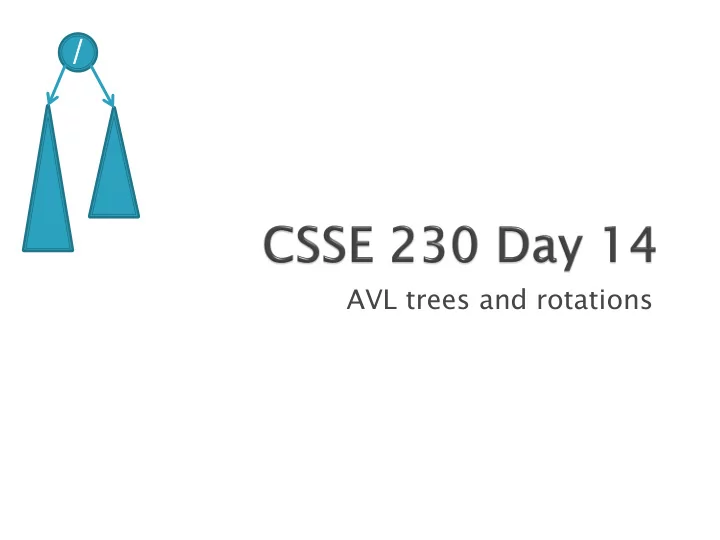

/ AVL trees and rotations
Q1 Q1 Operations (insert, delete, search) are O(height) Tree height is O(log n) if perfectly balanced ◦ But maintaining perfect balance is O(n) Height-balanced trees are still O(log n) ◦ For T with height h, N(T) ≤ Fib(h+3) – 1 ◦ So H < 1.44 log (N+2) – 1.328 * AVL (Adelson-Velskii and Landis) trees maintain height-balance using rotations Are rotations O(log n)? We’ll see…
= / \ or or or or Different representations for / = \ : Just two bits in a low-level language Enum in a higher-level language
/ Assume tree is height-balanced before insertion Insert as usual for a BST Move up from the newly inserted node to the lowest “unbalanced” node (if any) ◦ Use the ba balance c code ode to detect unbalance - how? Do an appropriate rotation to balance the sub-tree rooted at this unbalanced node
For example, a single left rotation :
Two basic cases ◦ “See saw” case: Too-tall sub-tree is on the outside So tip the see saw so it’s level ◦ “Suck in your gut” case: Too-tall sub-tree is in the middle Pull its root up a level
Q2 - 3 Unbalanced node Middle sub-tree attaches to lower node of the “see saw” Dia iagrams a are re f fro rom Data S Structu ctures by E E.M. M. Reingold ld and W.J W.J. Hanse sen
Q4-5 Q4 Unbalanced node Pulled up Split between the nodes pushed down Weiss calls this “right-left double rotation”
Q6 Q6 Write the method: static BalancedBinaryNode singleRotateLeft ( BalancedBinaryNode parent, /* A */ BalancedBinaryNode child /* B */ ) { } Returns a reference to the new root of this subtree. Don’t forget to set the balanceCode fields of the nodes.
Write the method: BalancedBinaryNode doubleRotateRight ( BalancedBinaryNode parent, /* A */ BalancedBinaryNode child, /* C */ BalancedBinaryNode grandChild /* B */ ) { } Returns a reference to the new root of this subtree. Rotation is mirror image of double rotation from an earlier slide
Q7 Q7-10 10 Both kinds of rotation leave height the same as before the insertion! Is insertion plus rotation cost really O(log N)? Insertion/deletion in AVL Tree: O(log n) Find the imbalance point (if any): O(log n) Single or double rotation: O(1) in deletion case, may have to do O(log N) rotations Total work: O(log n)
Depends on the first two links in the path from the lowest node that has the imbalance (A) down to the newly-inserted node. First link Second link Rotation type (down from A) (down from A's (rotate "around child) A's position") Left Left Single right Left Right Double right Right Right Single left Right Left Double left
Insert HA into the tree, then DA , then O . Delete G from the original tree, then I , J , V .
Star tart w with ith a an emp mpty A AVL VL tre tree. Add elements in the following order; do the appropriate rotations when needed. ◦ 1 2 3 4 5 6 11 13 12 10 9 8 7 How should we rebalance if each of the following sequences is deleted from the above tree? ◦ ( 10 9 7 8 ) ( 13 ) ( 1 5 ) ◦ For each of the three sequences, start with the original 13 -element tree. E.g. when deleting 13, assume 10 9 8 7 are still in the tree. Work ork w with ith y you our Dou r Doublets pa partn rtner. When you ou f fin inis ish, w work ork on on Dou Doublets or or WA5. Or r write rite th the rotate teDou Double bleRigh ight code ode f fro rom a a pre previous slide lide
Recommend
More recommend